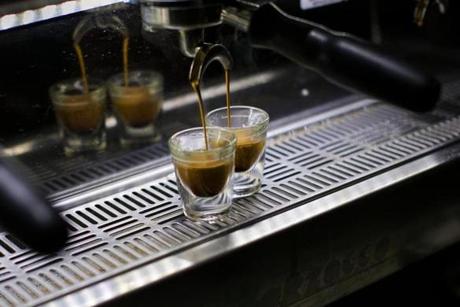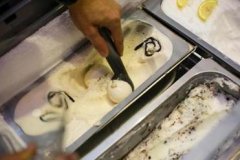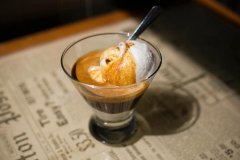Honduras Coffee Bean Flavor Description How to Drink Honduran Coffee

For professional baristas, please follow the coffee workshop (Wechat official account cafe_style)
The flavor of Honduran coffee beans describes how to drink Honduran coffee.
In 2011, Direct Coffee was introduced to Finca Santa Marta Santa Mata Manor in Ocotepeque Ocotepec, the winner of the 2006 C.O.E Coffee Competition and the top coffee farm in Honduras.
Property Characteristics: farm characteristics
Farm name: Finca Santa Marta Santa Mata
City City: Tegucigalpita, Yoro
Region producing area: Ocotepeque Ocotepec
Country countries: Honduras Honduras
Altitude altitude: 1250-1480 m
Farm Size farm size: 59 Hectares 59 ha
Coffee growing area Coffee planting area: 3 Murray 5 Hectares ha
Annual Precipitation annual rainfall: 1300 haomi mm
Soil soil: Clay loam, sandy loam clay, sandy soil
Annual Production annual output: 400 bags of green coffee beans 400 bags of raw beans
Certification Certification: organic Organic
Shade Trees shade tree species: Guama, Liquidambar, Oak, Cedar, Guajiniquel and Musaceas melon horse, maple tree, oak, cedar, plantain
Water Source Water Source: natural Water Source of Natural Water Sources from the Santa Marta Farm Farm
Coffee Characteristics: coffee characteristics
Variety variety: Catuai Kaduai
Processing System treatment: Washed washing drying on the sun table
Flowering period flowering period: September-October September to October
Harvest period harvest time: Handpicked from January through March is harvested manually from January to March.
Appearance appearance: 18 eyes
Awards won the award: 2006 Cup of Excellence, 1st place (2006 COE champion)
Top Jury Descriptions comment: the baking degree (Cinnamon) measured by the cup at the beginning of 60 seconds of explosion.
Aroma aroma / flavor flavor: peanut, nut, almond, licorice, hazelnut, jasmine, carambola, kumquat, honey, sugar cane, brown sugar, maltose, frankincense
Acidity: very fresh, clean, low acidity, citrus, berries, mint, low complexity, smooth sour taste
Complex complexity and other other: good balance, medium-long finish, smooth oil ester taste, the finish is very sweet, smooth and silky without impurities
Cup test score and overall review of direct coffee
Cup test date: 2011.03.05
Dry aroma: 9
Wet aroma: 8
Clean: 9
Brightness: 9
Taste: 7
Balance: 9
Complexity: 7
Sweetness: 9
Acid quality: 7
Yu Yun: 8
Cup test score: 82
Overall comment: Finca Santa Marta Santa Marta Manor in Honduras has been working with foreign coffee buyers since it won the first place in the coffee contest in 2006. Coffee beans can maintain excellent quality, like the lively peanut aroma of coffee after grinding, and the tea feel of jasmine tea after coffee is cold. Mild, crisp and delicious is a good manor in Honduras with few shortcomings.
Washing of Pacas + IH90 varieties in Saint Vincent treatment Plant, Honduras
(Honduras San Vicente Edgardo Tinoco Pacas + IH90)
Producing area: Pena Blanca town, Santa Barbara (Santa Barbara)
Processing plant: St. Vincent treatment plant (Beneficio San Vicente)
Variety: Pacas + IH90 (one of the new varieties developed by the Honduran Coffee Association)
Grade: SHG
Altitude: 1300 to 1500 m
Certification: NCMA
Flavor features: almonds, cedar, dark chocolate, dark fruit,
Plum caramel, thick taste.
Introduction:
Coffee was grown in Honduras in 1804 and now has 280000 hectares of coffee plantations.
All of them are mainly small coffee farmers, and the planting area of their coffee plantations is mostly less than 3.5 hectares.
Coffee farmers account for 60% of Hongguo's coffee production. Coffee production in Honduras in 2011
Surpassed Guatemala and became the second largest exporter of washed Arabica beans in the world in 2012.
Second only to Brazil. It now ranks seventh in global production. Coffee cultivation is not like a banana garden.
Owned by two large American consortia and oligarchs, 92% of Honduran coffee farmers are small individuals.
Coffee-related workers account for 12.5% of the total population of 8 million, so coffee is in Honduras.
Is a very important crop. In the coffee garden, coffee farmers harvest red fruit, wash it, ferment it and add it.
To grade according to the needs of the market to meet the needs of different tastes of consumers. Honduras
3 million bags of coffee are harvested every year to provide good quality coffee and unique coffee flavor.
With a large quantity and excellent quality, it has become the largest producer in Central America and one of the top ten in the world.
Coffee exporter. The coffee industry in Honduras involves the livelihoods of hundreds of thousands of families across the country.
Provide one million jobs for important economic agriculture in Honduras.
Large coffee producing areas in Honduras, including Copan and Opalaca in western and southern areas.
, Montecillos, Comayagua, Agalta, El Paraico, etc.
The average planting height is above sea level. The variety of coffee is 100%
Arabica species, 69% belong to HG class, 12% are SHG,19% and CS. Mainly grow coffee
Varieties include Typica, Bourbon, Caturra, Villa Sarchi and Lempira.
Honduran coffee has always been of high quality, and its price is the most competitive in Central American countries.
Small, round, slightly bluish-green coffee, mild sour, full and slightly sweet
Suitable for both mixed coffee and single coffee, suitable for medium to deep roasting
Mainly exported to the United States, Germany and Japan. Honduras is already the first largest in Central America.
Coffee producing countries, whose output has been increasing in recent years, due to high international coffee prices in 2012.
The output of coffee in this year exceeded 5 million bags in 2010, with a great increase in production and continuous improvement in quality.
The largest coffee province in Honduras is the The Santa Barbara region, which is located in western Honduras.
Is in the northwest of Lake Yojoa, an area that has developed into Honduras in the past few years.
Famous coffee producing area. At the same time, this area comes from a famous agronomist Mr. Angel Arturo Paz
He owns a post-processing plant, St. Vincent's treatment Plant (San Vicente), in the western Yojoa Lake.
The small town of Pe ñ a Blanca in the northern Santa Barbara province (Santa Barbara)
He has always been the winner of the COE (Cup of Excellence) Cup in Honduras. St. Vincent treatment plant
Acquire the surrounding towns of El Cielito, Las Flores and El Cedral (these
Each place has at least 35 families and one school) coffee cherries produced by small coffee farmers.
Although the number is so small that it is usually difficult to separate these small farmers' output batches.
But the coffee produced in these regions has always been amazing with high sweetness and fruity.
St. Vincent (San Vicente) is a family-run processing plant that is well known locally.
As a result of assisting farmers to upgrade their planting technology and improve production equipment through projects, they are committed to investing in
The close contact of the producer, and take the coffee cup test as each batch of products strictly guarded.
This batch of St. Vincent treatment Plant Tropical Rainforest Certification SHG is a processing plant to acquire the surrounding area.
Small coffee farmers combine production and marketing, because the average planting area of each small coffee farmer is only
1Mel 2 hectares, the kilograms of raw beans for coffee production can not be sold independently, but can only be combined.
The whole batch of marketing together is a bit like a co-operative or a coffee production and marketing shift.
This batch of Saint Vincent (San Vicente) Ecuadorian small farmers (Edgardo Tinoco) is produced from
Edgardo Tinoco, a small village nearby, a collection of small coffee farmers, the planting area of general small farmers
Very small, can not handle the sale of raw beans alone, can only be sold to the processing plant concentrated quantity to sell together.
Flavor features: almonds, cedar, dark chocolate, dark fruit, plum caramel, thick taste.
Rainforest Certification Rainforest Certification
Manor
Finca La Lesquinada
Producing area
Aldea Cerro Negro Copan, Honduras
Altitude
1650m
Treatment method
Solarization method
Baking degree
Medium baking
Flavor description of the winner of the World Cup
Hazelnut, pine, apricot
Honduras has always been among the top few in the boutique coffee market, but Honduras has the advantages of natural environment, such as excellent soil quality, altitude and climatic conditions. Nearby Guatemala, El Salvador and Nicaragua also have advanced coffee production. What Honduras lacks is infrastructure and its reputation in the consumer market is not good enough. Hongguo is better known for commercial beans than boutique beans. No matter how good the quality is, there is no way to sell them at a good price. Many beans from Koban and Santa Barbara are mixed with fish eyes as Guatemala beans, and they are sold at the price of Guatemalan beans, and for a long time they are not aware of their own potential for the cultivation of high-quality coffee beans. The main problem is that coffee cherries are only slightly processed. It is sold to the processing plant when it is still wet, which often causes coffee cherries to become moldy and damaged before they are officially dried until the moisture content is only 12%. Such cherries become defective beans after drying. Since there is no relative price return for good quality, coffee farmers, processors and exporters have no incentive or incentive to increase costs to develop the potential for coffee cultivation, so that the end of Honduran coffee beans has become recognized as a mild mixed bean. rather than beans from a single origin or unique farm, this is a vicious circle.
But now it's different, with the help of USAID and Fintrac and several cooperatives like La Central, they try their best to promote and educate Macro bean farmers to produce good coffee, and then properly handle it to maximize the flavor of the final coffee. In addition, the Fair Trade Association (Fair Trade) funded the construction of processing equipment and increased the expertise of coffee farmers to gradually bring Honduran coffee out of the trough. It has become a burgeoning Central American coffee in the past year or two.
Cooking method
Recommended water temperature 88-92 ℃ water, grinding scale 4 (bean mill Tiamo 700s HG0421), 20g powder
(1) pre-soak 50 grams of water for 30 seconds
(2) inject water until the total amount is 300 grams, soak for 1 minute and 20 seconds and then drop.
(3) remove the filter cup in two minutes.
Honduras is as diverse as other producing countries, and I can't cover them all in one way. The largest producing area is Santa Barbara Santa Barbara, and there are other producing areas such as Copan Koban, Ocotepeque Ocotepec, Lempira Lompilla, La Paz Baz, and El Paraiso Periso in the south, which are planted at an altitude of 1500 meters to 2000 meters above sea level. Mainly grow extremely high sea beans (SHG) generally speaking, the Honduran coffee we have recently tested has low acidity, high sweetness and obvious caramel flavor, which is an excellent choice for espresso beans.
Honduras Honduras
Population: 8250000
Although it is not described by HCAFE as a coffee growing area, many roasters label coffee from the Santa Barbara region of Honduras (Santa Barbara), and several coffee areas cross into Santa Barbara (a country's government ministry). Some would say that it needs its own description, but the more appropriate way seems to be to list the planting areas in accordance with official principles. There are also some excellent Pacas varieties from the Santa Barbara region, which are of good quality and have a unique and fruity flavor, which is definitely worth pursuing.
COPAN
The Copan producing area is located in the city of Copan in western Honduras, of which the most famous is the local Mayan site. The region is adjacent to Guatemala and regions like this remind me to attach importance to the actual origin of coffee rather than to producing countries. In fact, the division of countries is somewhat arbitrary, because it is difficult (unfortunately) for consumers to distinguish between coffee beans from Honduras or from Guatemala. Copan production area is located in the north of the Santa Barbara Coffee area.
Altitude: 1000-1500m
Harvest: November-March
Variety: bourbon, Caturra,Catuai
OPALACA
Opalaca producing areas are located in the southern part of Santa Barbara, as well as Intibuka and Intibuca and Lempira. Named after the Opalaca Mountains that stretch through the area.
Altitude: 1100-1500m
Harvest: November-February
Variety: bourbon, Catuai,Typica
Honduras-2006 C.O.E champion Manor Santa Mata Manor (Finca Santa Marta)
Madasano Manor-El Matazano, located between La Paz and Makala, owned by Francis Francisco Antonio Castillo David
Francis can reclaim coffee in 1995 and work with four families to plant and reprocess. The ferocious leaf embroidery disease in the past two years has reduced the yield by 50%, so we can only work harder to carry out disease control and stricter quality control.
This year, Mada Sano maintained an excellent tradition to win the Excellence Cup. Francis said that the level of beans participating in Honduras is so good that it is very difficult to enter the international evaluation stage and win. Thanks to the close cooperation of four family members, we can win the prize again.
Oushe purchased the same batch of beans for competitive bidding, only 15 bags, we promised Francis, as long as we maintain the same level, we are willing to purchase for a long time!
Basic information:
Manor: Madasano Manor-El Matazano
Landowner: Francis Anthony (Francisco Antonio Castillo David)
Manor area: 3 hectares
Cultivated varieties: Cartaiyi, Catuai
Altitude: 1500-1600 m
Production area: El Matazano, Tutule, La Paz, Honduras
Annual output: 80 bags
Harvest time: April 2015
Treatment method: washing method. The latter part of the sun shed frame insolation.
This batch is marked: Osher is directly related to coffee
Quantity: 15 bags
The cup tests the flavor:
Honey, caramel sweet, sour bright and sweet, blackcurrant, grapefruit, vanilla plant, chocolate, nuclear fruit
Important Notice :
前街咖啡 FrontStreet Coffee has moved to new addredd:
FrontStreet Coffee Address: 315,Donghua East Road,GuangZhou
Tel:020 38364473
- Prev

The characteristics of Honduran Coffee introduction to the types of coffee in Honduras
For the exchange of professional baristas, please follow the coffee workshop (Wechat official account cafe_style) the characteristics of Honduran coffee the category of Honduran coffee introduced the Saint Vincent processing Plant of Honduras Pacas + IH90 Variety washing (Honduras San Vicente Edgardo Tinoco Pacas + IH90) production area: Santa Barbara (Santa Barbara) Pena Blan
- Next

What are the characteristics of coffee beans in Panama's Ireta Manor? how much is the Panamanian Ireta Manor Coffee?
Professional barista exchanges please follow the coffee workshop (Wechat official account cafe_style) Panama Ireta Manor Coffee beans what are the characteristics of Panama Ireta Manor Coffee how much (Panama MC Santa Clara Eleta SHB Washed) production area: Santa Clara (Santa Clara) Manor: Fox Manor (Finca Eleta) species: card
Related
- Does Rose Summer choose Blue, Green or Red? Detailed explanation of Rose Summer Coffee plots and Classification in Panamanian Jade Manor
- What is the difference between the origin, producing area, processing plant, cooperative and manor of coffee beans?
- How fine does the espresso powder fit? how to grind the espresso?
- Sca coffee roasting degree color card coffee roasting degree 8 roasting color values what do you mean?
- The practice of lattes: how to make lattes at home
- Introduction to Indonesian Fine Coffee beans-- Java Coffee producing area of Indonesian Arabica Coffee
- How much will the flavor of light and medium roasted rose summer be expressed? What baking level is rose summer suitable for?
- Introduction to the characteristics of washing, sun-drying or wet-planing coffee commonly used in Mantenin, Indonesia
- Price characteristics of Arabica Coffee Bean Starbucks introduction to Manning Coffee Bean Taste producing area Variety Manor
- What is the authentic Yega flavor? What are the flavor characteristics of the really excellent Yejasuffi coffee beans?

